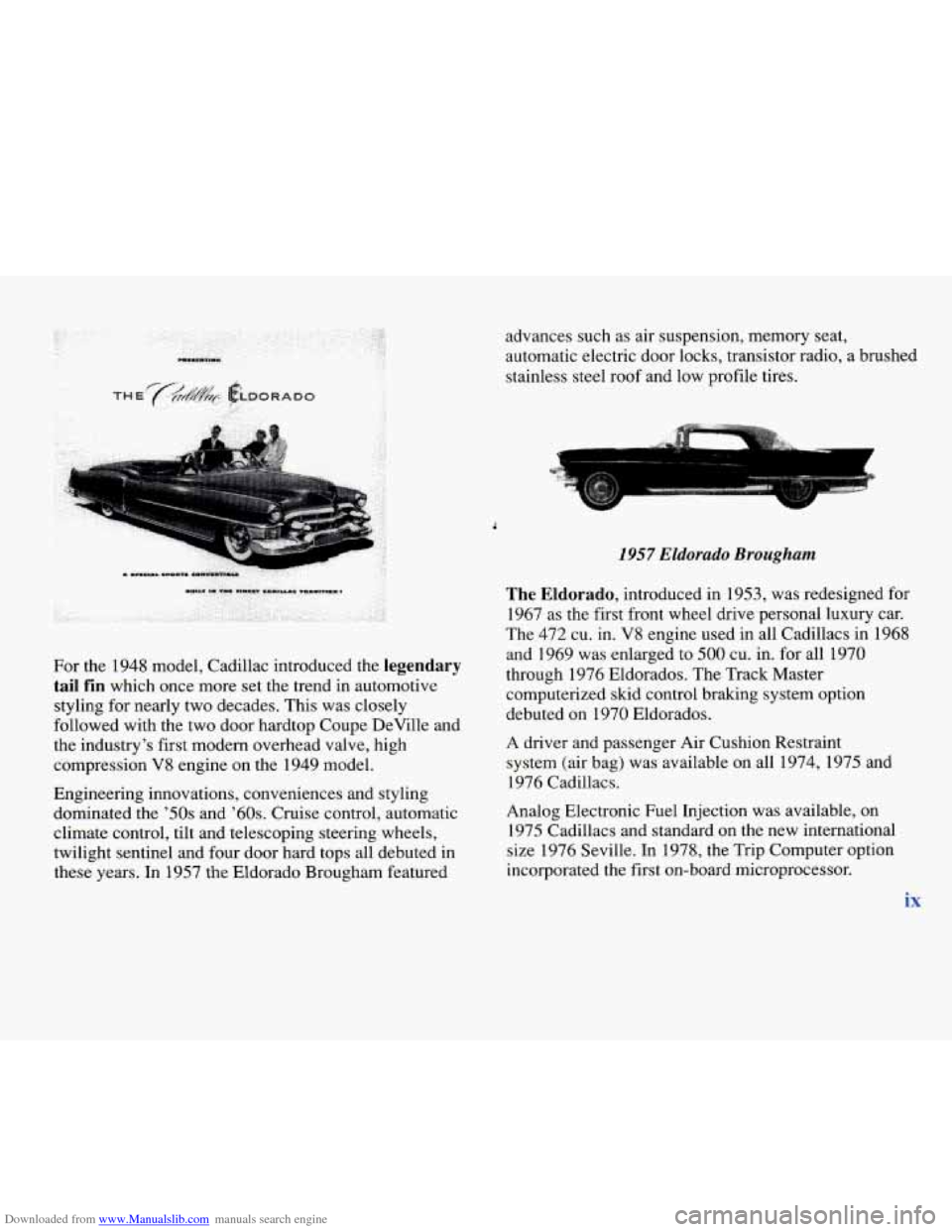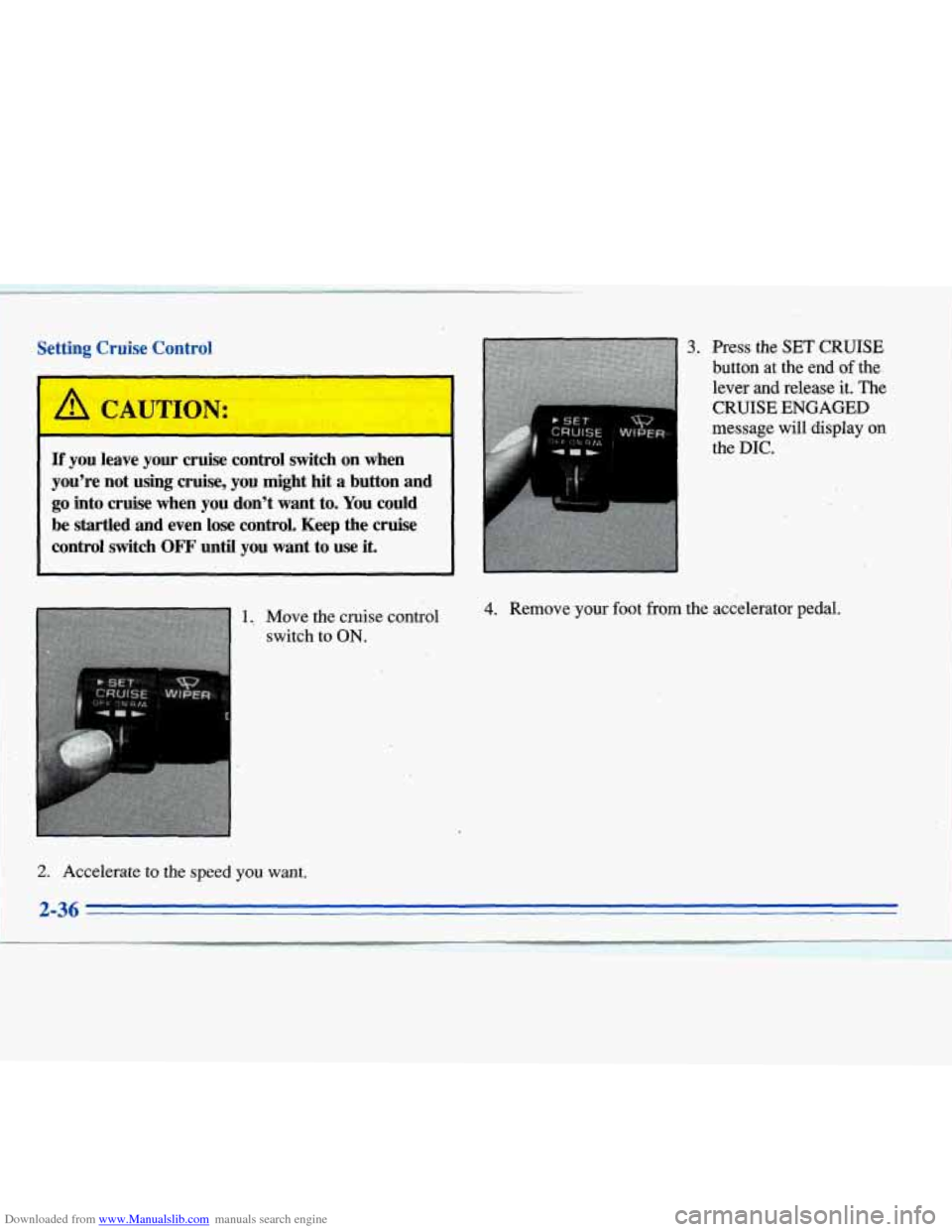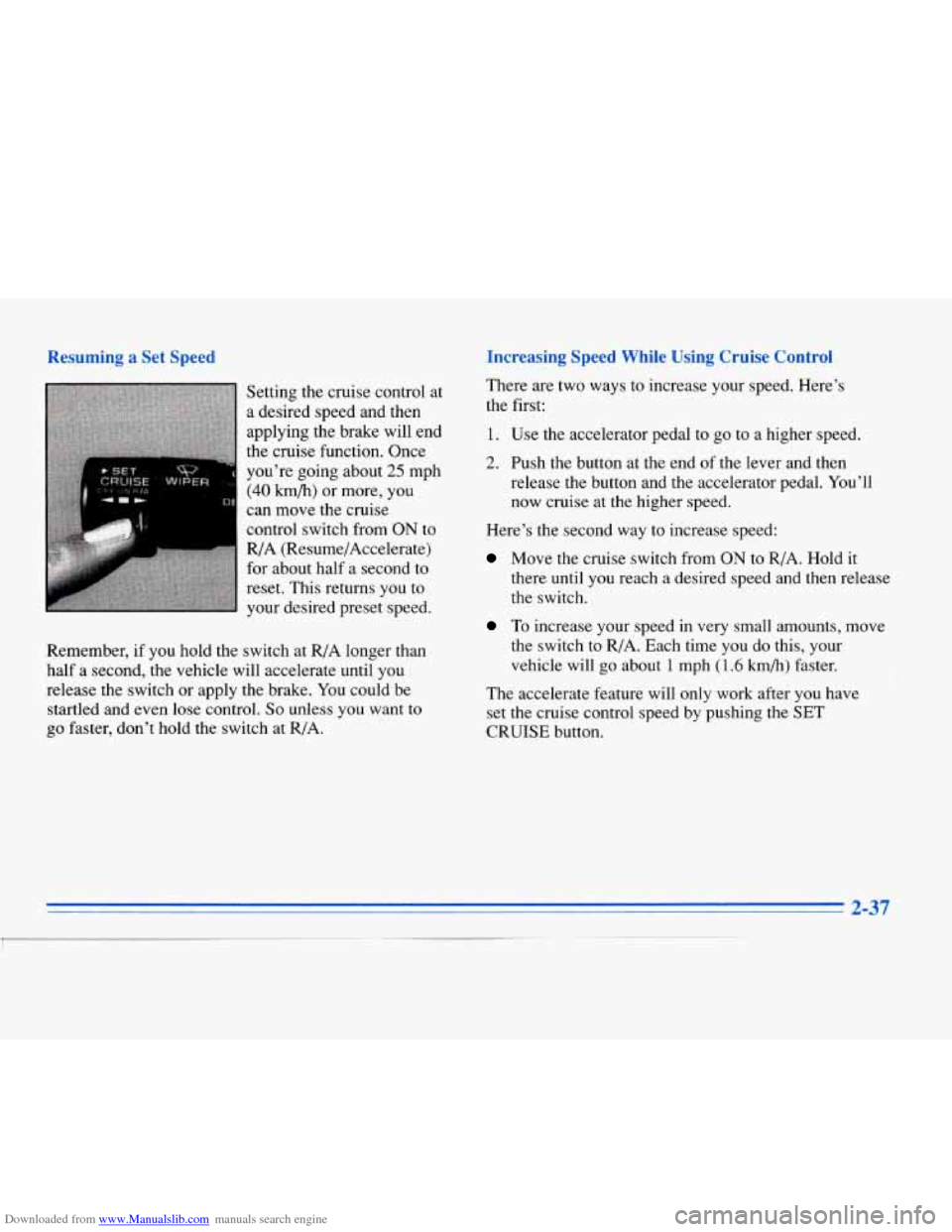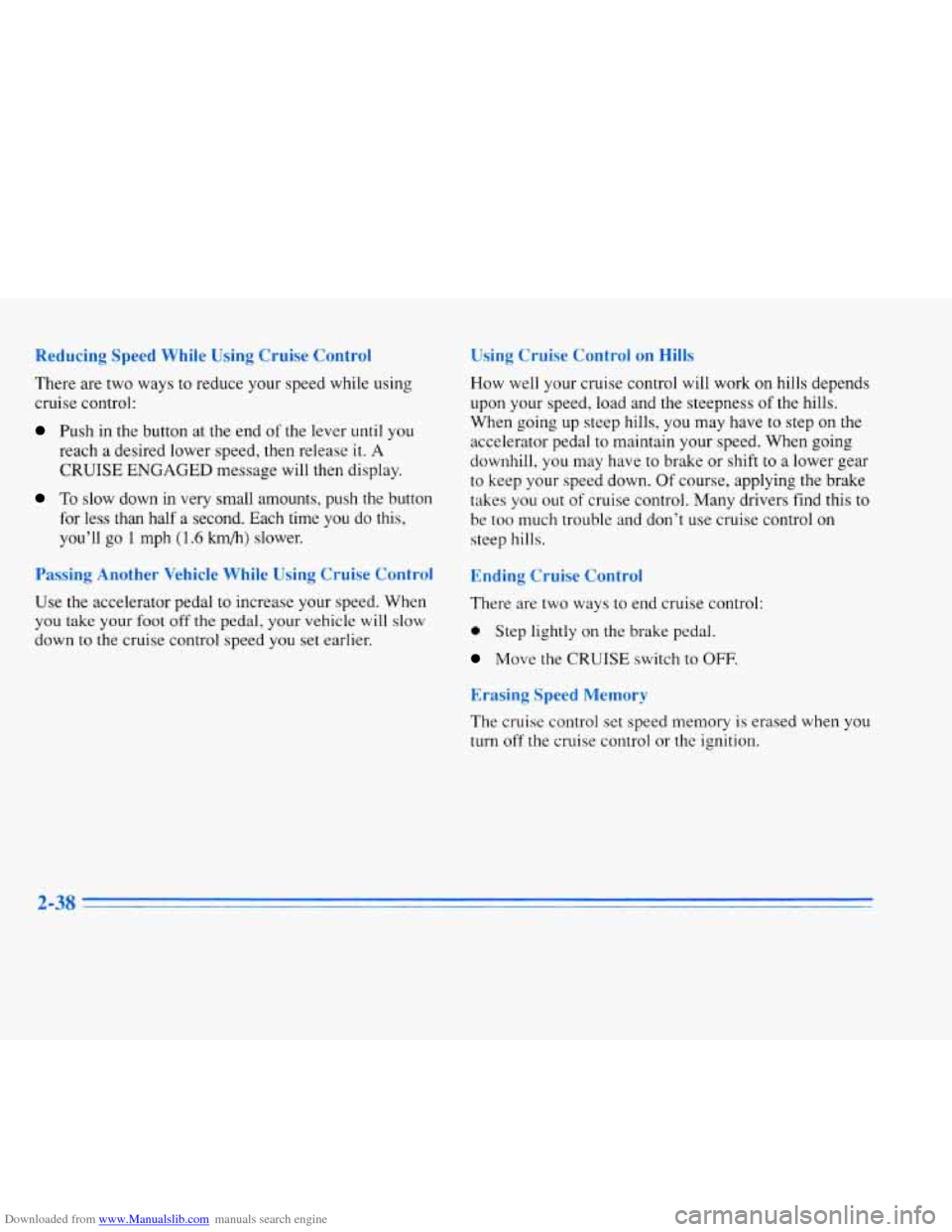1996 CADILLAC ELDORADO cruise control
[x] Cancel search: cruise controlPage 10 of 354

Downloaded from www.Manualslib.com manuals search engine ...
For the 1948 model, Cadillac introduced the legendary
tail
fin which once more set the trend in automotive
styling for nearly two decades. This was closely
followed with the two door hardtop Coupe DeVille and
the industry's first modem overhead valve, high
compression V8 engine on the 1949 model.
Engineering innovations, conveniences and styling
dominated the
'50s and '60s. Cruise control, automatic
climate control, tilt and telescoping steering wheels,
twilight sentinel and four door hard tops all debuted in
these years.
In 1957 the Eldorado Brougham featured advances such
as air suspension, memory seat,
automatic electric door locks, transistor radio, a brushed
stainless steel roof and low profile tires.
1957 Eldorado Brougham
The Eldorado, introduced in 1953, was redesigned for
1967 as the first front wheel drive personal luxury car.
The 472 cu. in.
V8 engine used in all Cadillacs in 1968
and 1969 was enlarged to
500 cu. in. for all 1970
through 1976 Eldorados. The Track Master
computerized skid control braking system option
debuted on 1970 Eldorados.
A driver and passenger Air Cushion Restraint
system (air bag) was available on all 1974, 1975 and
1976 Cadillacs.
Analog Electronic Fuel Injection was available, on
1975 Cadillacs and standard on the new international
size 1976 Seville. In 1978, the Trip Computer option
incorporated the first on-board microprocessor.
ix
Page 96 of 354

Downloaded from www.Manualslib.com manuals search engine Cruise Control
I
With cruise control, you can maintain a speed of about
25 mph (40 kmb) or more without keeping your foot on
the accelerator. This can help on long trips. Cruise
control does not work at speeds below about
25 mph
(40 hb).
Cruise control shuts off when you apply your brakes.
I
Cruise control can be dangerous where you
can’t drive safely at
a steady speed. So,
don’t use your-cruise control on winding
roads or in heavy traffic.
slippery roads. On such roads, fast changes
in tire traction can cause needless wheel
spinning, and you could lose control. Don’t
use cruise control on slippery roads.
Cruise control can be dangerous on
If your vehicle is in cruise control when the traction
control system begins to limit wheel
spin, the cruise
control will automatically disengage. (See “Traction Control System” in the Index.) When road conditions
allow you to safely use
it again, you may turn the cruise
control back on.
2-35
Page 97 of 354

Downloaded from www.Manualslib.com manuals search engine Setting Cruise Control
If you leave your cruise control switch on when
you’re not
using cniise, you might hit a button and
go into cruise when you don’t want to. You could
be startled and even
lose control. Keep the cruise
control
switch OFF until you want to use it.
Press the SET CRUISE
button at the end of the.
lever and release it.
The
CRUISE ENGAGED
message will display on
the DIC.
Move the cruise control
switch to
ON.
4. Remove your foot from the accelerator pedal.
2. Accelerate to the speed you want.
2-36
Page 98 of 354

Downloaded from www.Manualslib.com manuals search engine Kernember, if you hold the Setting the
cruise control at
a desired speed and then
applying the brake will end
the cruise function. Once
you’re going about
25 mph
(40 km/h) or more, you
can move the cruise
control switch from
ON to
R/A (Resume/Accelerate)
for about half a second to
reset. This returns you to
your desired preset speed. There are two ways to increase your speed.
Here’s
the first:
1. Use the accelerator pedal to go to a higher speed.
2. Push the button at the end of the lever and then
release the button and the accelerator pedal. You’ll
now cruise at the higher speed.
Here’s the second way to increase speed:
Move the cruise switch from ON to R/A. Hold it
there until you reach a desired speed and then release
the switch.
switch at R/A longer than
half
a second, the vehicle will accelerate until you
release the switch or apply the brake.
You could be
startled and even
lose control. So unless you want to
go faster, don’t hold the switch at R/A.
To increase your speed in very small amounts, move
the switch to R/A. Each time you do this, your
vehicle will
go about 1 mph (1.6 km/h) faster.
The accelerate feature will only work after you have
set the cruise control speed by pushing the
SET
CRUISE button.
Page 99 of 354

Downloaded from www.Manualslib.com manuals search engine Reducing Speed While Using Cruise Control
There are two ways to reduce your speed while using
cruise control:
Push in the button at the end of the lever until you
reach a desired lower speed, then release
it. A
CRUISE ENGAGED message will then display.
To slow down in very small amounts, push the button
for less than half a second. Each time you do this,
you’ll go
1 mph (1.6 km/h) slower.
Passing Another Vehicle While Using Cruise Control
Use the accelerator pedal to increase your speed. When
you take your
foot off the pedal, your vehicle will slow
down to the cruise control speed you set earlier.
Using Cruise Control on Hills
How well your cruise control will work on hills depends
upon your speed, load and the steepness
of the hills.
When going up steep hills, you may have to step on the
accelerator pedal to maintain your speed. When going
downhill, you may have to brake or shift
to a lower gear
to keep your speed down.
Of course, applying the brake
takes you out
of cruise control. Many drivers find this to
be too much trouble and don’t use cruise control on
steep hills.
Ending Cruise Control
There are two ways to end cruise control:
0 Step lightly on the brake pedal.
Move the CRUISE switch to OFF.
Erasing Speed Memory
The cruise control set speed memory is erased when you
turn
off the cruise control or the ignition.
Page 191 of 354

Downloaded from www.Manualslib.com manuals search engine Remember: Anti-lock doesn’t change the time you need
to get your
foot up to the brake pedal or always decrease
stopping distance. If you get too close to the vehicle in
front of you, you won’t have time to apply your brakes
if that vehicle suddenly slows or stops, Always leave
enough room up ahead to stop, even though you have
anti-lock brakes.
Don’t pump the brakes. Just hold
the brake pedal down
and let anti-lock work for you. You may hear the
anti-lock pump or motor operate, and feel the brake
pedal pulsate, but this
is normal. Your
vehicle has a traction control system that limits
wheel spin.
This is especially useful in slippery road
conditions. The system operates only
if it senses that one
or both of the front wheels are spinning or beginning to
lose traction. When this happens, the system works the
front brakes and reduces engine power to limit wheel
spin.
The
TRACTION ACTIVE message will display on the
Driver Information Center when the traction control
system
is limiting wheel spin. See “Driver Information
Center Messages” in the Index. You may feel or hear the
system working, but this is normal.
If your vehicle is in cruise control when the traction
control system begins to limit wheel spin, the cruise
control will automatically disengage. When road
conditions allow you
to safely use it again, you may
reengage the cruise control. (See “Cruise Control” in
the Index.)
Page 315 of 354

Downloaded from www.Manualslib.com manuals search engine INT LPS CIG LTAl
LHDLP Lo R HDLPLO LHDLPHI RHDLP HI SENSE
, HDLPS , I HAZARD I , STOP I I MIRROR , I FOGIDRL ,
IGN O(ENG) CRANK WIPERS
FUSE CENTER IDENTIFICATION
- - -
OXY SEN2 OXY SEN1 FUEL PUMP
CRUISE RELAY
DISTR PCM(IGN ECS ndn - ---
PCM BAT AIC COMP n& n I
AiC COMP RE LAY
FRONT OF VEHICLE 3648830 / I
--- I '/
Fuse Usage
INT LPS Trunk Lamp, Courtesy Lamps,
Front Vanity Lamps, Glove
Box
Lamp, Garage Door Opener,
Courtesy Lamp Relay
CTG LTRl Front Cigarette Lighter (Full
Console Only), Rear Lighter
L HDLP LO Left Low-Beam Headlamp
Fuse
R HDLP LO
L HDLP HI
R HDLP HI
SENSE
-
HDLPS
HAZARD
STOP
Usage
Right Low-Beam Headlamp,
Light Emitting Diode (LED) on
Headlamp Switch
Left High-Beam Headlamp
Right High-Beam Headlamp Heated Windshield Control
(Optional)
Headlamp Switch and Relay,
High/Low Beam Control Relay,
Right and Left
Low Beam (I-Beam),
Right and Left High Beam
Electronic Flasher Module,
Turn/Hazard Module, Right and Left Turn Lamps, Back-up Lamps, Right
and Left Front Turn Lamps, Right
and Left Repeater Lamps (Export)
Stoplamp Switch, Centered
High-Mounted Stoplamp
(CHMSL), Turn Hazard Switch,
ABS Controller. Stepper Motor
Cruise Control, Right and Left
Rear Stoplamps
Page 316 of 354

Downloaded from www.Manualslib.com manuals search engine Fuse
MIRROR
FOG/DRL
IGP
. JO (ENG)'
CRANK
S
t
Usage
Inadvertent Power Relay, Outside
Rearview Mirror, Data Line
Connector (DLC), Flash-to-Pass
Module
Daytime Running Lamp (DRL)
Relay (Domestic Only), Fog Lamp
Relay (Optional), Headlamp
Switch, Right and Left Front Fog
Lamps (Optional)
Powertrain Control Module (PCM)
Sensing and Diagnostic Module
Anti-Lock Brake System/Anti-Slip
Regulation-5 (ABS/ASR-5) Controller
Rear Ignition-
1 Relay, Front Fog
Lamp Relay, Rear Lamp Relay (Export), Controlled Power
Back-up Relay, DRL Relay
(Domestic Only) (SDM)
Fuse
WIPERS
OXY SEN2*
OXY SENl*
FUEL
PUMP*
INJ*
INJ*
CRUISE
DISTR*
PCM (IGN)*
Usage
Accessory Relay, Wiper Switch,
Cluster, Wiper Motor, Wiper Pump
02 Sensor Rear, Catalytic
Converter (CAT) Rear
02 Sensor
02 Sensor Front, CAT Front 02
Sensor
Engine Oil Pressure Indicator, PCM, Fuel Pump Relay, Fuel Pump
Injectors
2, 3,5, 8
Injectors 1,4,6,7
Stepper Motor Cruise Control,
Park-Neutral Position Switch,
Back-up Lamps, Electrochromatic
Mirror, Brake-Transaxle Shift
Interlock (BTSI)
Electronic Ignition Control
PCM
6
I